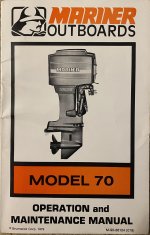naio83
New member
Hi to all, and thanks for accepting me on the forum. This is my first post.
I have a 1980 2T, 3 cylinder, 2 carb, 70hp Mariner on a 15 boat. Most of the time it was stored and with very little use.

At the beginning of this year I started to put it into value again to start using it since it was stored for the last 6 years.
- Compression checked of 150 on each cylinder.
- New Battery
- New gas tank
- New sparks
- New Fuel line
- Full Carbs rebuilt by local mechanic.
- New oil on the transmission.
The engine starts fine and runs smoothly with 1 or 2 persons on the boat, but If I try to go with 3 or 4 persons it loses power when it tries to reach the medium revs.
Especially if there are waves and the motor has to make an effort on putting the boat on plane. Sometimes, if the water is still and after a few attempts It makes it to the med/high revs and works fine for a while or even for the whole trip but the problem comes back the following day.
I tried to contact the mechanic several times and he said that he has checked the stator and the trigger already and that he doesn't know what else to check (it is not easy to find mechanics that want to get their hands dirty on those old motors where I live).
Things that I have considered and tried:
- Fuel pump / filter: The mech said it was ok.
- Water pump impeller : I test the water pressure, no overheating alarm.
- Double check on the fuel line.
- Squeeze the Primer ball when it happens.
- Check the gas venture.
I am adding a couple of videos with the boat with 3 persons onboard and trying to accelerate, if I keep on trying to accelerate the engine stops as in the second video:
Any help or piece of advice would be great!
Thanks in advance!!!
I have a 1980 2T, 3 cylinder, 2 carb, 70hp Mariner on a 15 boat. Most of the time it was stored and with very little use.

At the beginning of this year I started to put it into value again to start using it since it was stored for the last 6 years.
- Compression checked of 150 on each cylinder.
- New Battery
- New gas tank
- New sparks
- New Fuel line
- Full Carbs rebuilt by local mechanic.
- New oil on the transmission.
The engine starts fine and runs smoothly with 1 or 2 persons on the boat, but If I try to go with 3 or 4 persons it loses power when it tries to reach the medium revs.
Especially if there are waves and the motor has to make an effort on putting the boat on plane. Sometimes, if the water is still and after a few attempts It makes it to the med/high revs and works fine for a while or even for the whole trip but the problem comes back the following day.
I tried to contact the mechanic several times and he said that he has checked the stator and the trigger already and that he doesn't know what else to check (it is not easy to find mechanics that want to get their hands dirty on those old motors where I live).
Things that I have considered and tried:
- Fuel pump / filter: The mech said it was ok.
- Water pump impeller : I test the water pressure, no overheating alarm.
- Double check on the fuel line.
- Squeeze the Primer ball when it happens.
- Check the gas venture.
I am adding a couple of videos with the boat with 3 persons onboard and trying to accelerate, if I keep on trying to accelerate the engine stops as in the second video:
Any help or piece of advice would be great!
Thanks in advance!!!
Last edited:

